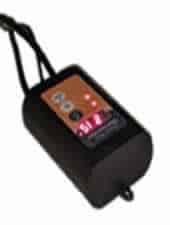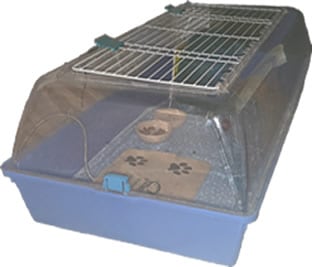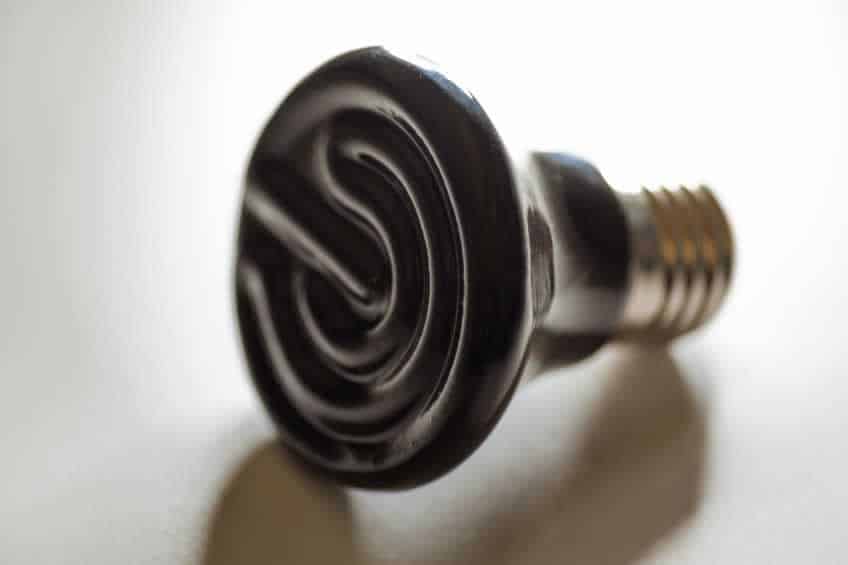
Keeping an hedgehog’s cage temperature ideal is essential as these types of hedgehogs could go into hibernation. We were worried about our hedgehog getting too cold and not recovering.
Please keep hedgehogs temperature controlled at all times. It is vital to keep a hedgehogs cage temperature between 72F (22C) and 80F (26.5C), as anything lower than this could make them lethargic and possibly cause them to go into hibernation and anything higher than this could cause them to go into aestivation (heat stroke).
In the following part of the article I will look into the details what’s important in helping maintain a safe temperature for a hedgehog.
1. Know the ideal temperature
The ideal temperature for hedgehogs is between 72F (22C) and 80F (26.5C). It’s essential to maintain this temperature in the areas where they sleep and if possible where they feed and play. Keeping the whole cage at this temperature may not be an option and for us to do so would mean to either have our central heating on all the time in the colder months or use a low running cost space heater.
The space heater option is really only suited for small rooms and our hedgehog is kept in a larger room where a space heater would simply not be effective enough.
We try to keep the room temperature at a minimum of 64F (18C), never rising over 82F (28C) as this helps in ensuring it’s warm enough for the hedgehog to come out into the open at night. We’re lucky we have good insulation helping retain the heat built up over the day and with windows easily opened to cool the house down.
Air conditioning isn’t something I would see as good for hedgehogs as this would bring the overall temperature down not only in the day but would keep the temperature down in the night even when the air conditioning has been switched off.
2. Use a thermometer in the cage
The correct way to ensure the temperature is correct is to use a thermometer placed inside the cage and not to rely on any form of a temperature reading from outside the cage.
Our central heating has a panel showing the average temperature in our house and this is always lower than the thermometer we have in the hedgehog’s cage. It’s essential to have some form of a reliable temperature reading from the cage and that’s why we rely on the readings from the thermometer stuck to the inside of the cage.
Any device for taking the inside cage temperature must be safe for your hedgehog, stopping them from getting hurt and also providing protection from the hedgehog chewing on any cables. The last thing anyone would want is their hedgehog getting electrocuted from chewing a cable.
3. Heat their house
The hedgehog house in the cage is the place where they sleep and most likely to slip into a hibernation state if it gets too cold. It makes a lot of sense to keep this area around the ideal temperature.
We use a heating pad also known as a heat mat, with a thermostat automatically controlling the temperature and making sure the heat pad comes on if the cage temperature drops below 72F (22C) and switching the heat pad when the temperature in the cage goes above 80F (26.5C).
Our hedgehog’s house is placed on top of the heat mat and we put fleece liner above the house, allowing him to come out of his house and sleep next to the house should it become too warm inside the house, all whilst being covered by the darkness of the fleece.
The heat mat has an easily removable cover, which can be unzipped and changed over once a week. As anything stuck to his feet and fur can build up on the heat mat cover and start to smell.
4. Heat their feeding area
Once hedgehogs are awake in the hours of darkness they will go out of their house in search of food and inside a cage, this means heading off towards where the food and water are kept. We have a running wheel next to where the food and water are kept, this is used quite extensively by our hedgehog in the night as he walks and walks for hours.
It’s imperative some form of heating is available in this area when the overall temperature in the house falls, as the resulting temperature in the cage will fall. This becomes more important as the hedgehog becomes older as they’ll find the cold more unbearable a bit like how we as humans find the cold problematic as we age.
Hedgehogs will simply not come out for long periods if the temperature of their feeding and play area is cold. They will simply come out and feed quickly and then go back to their warm house. Missing out on vital exercise resulting in the hedgehog becoming fat and this is not a good thing as it can affect their overall wellbeing.
It’s possible with some cages to use a ceramic heat emitter also known as a heat lamp to provide additional heating in the feeding and playing areas of the cage. However, as we have a Zoo Zone plastic bottom cage, this is a fire hazard, so we are looking at investing in another heat mat to place in the feeding and playing area.
If you are not using a plastic cage or any other potential fire hazard cage, then using a ceramic heat emitter maybe a good idea. Just make sure the ceramic heat emitter only emits heat and not any light as well, as any light will stop your hedgehog coming out at night.
5. Watch out for cold drafts
At the human level the cage may look warm and snug but at the hedgehog level, there may be drafts of air circulating making the cage cooler than appreciated for the hedgehog.
These drafts of air will keep the hedgehog out of the essential areas they need to go and if the drafts are coming into their house, this could make their body think it’s time to go into hibernation.
Having a cover like the one we have made of fleece can protect the sleeping areas from getting too cold as simply placing this over the hedgehog’s house keeps away any drafts. However cold drafts circulating in other areas will be more difficult to resolve unless the source of the draft is eliminated.
One of the easiest ways to find any sources of cold drafts is to use a candle and put it around the cage and see if the flame flickers, as this could be an indication of cold air.
Also keeping the hedgehog’s cage away from windows and doors can also help in keeping the cold air away. We keep our hedgehog cage on the other side of the room to the doors that lead into the conservatory area.
6. Make sure the cage size can be heated
It’s great to give hedgehogs plenty of space to roam around but this comes at the expense of keeping this space heated adequately. Larger cages can become quite difficult to heat and smaller cages whilst being easier to heat, may not provide enough space for a hedgehog.
We have a ZooZone large cage 100cm by 50 cm (3.2 feet by 1.65 feet) and this is a good size to keep warm, ideally, we want to get a slightly bigger cage that’s 122cm by 61cm (4 feet by 2 feet) as this will be an optimal size.
However, finding a suitable cage has been difficult as it’s not only the size that needs to be considered but also the safety of the materials used in the cage as some woods can be toxic to hedgehogs.
7. Watch out for Hibernation
Cold can make a hedgehog slip into hibernation as they’ve evolved to deal with warmer temperatures especially when their natural wild climate in Africa is not the same as the climates they are kept as pets in.
Keep an eye out for any symptoms of your hedgehog potentially being on the verge of hibernation and take action immediately to try to stop this. The following could easily be signs of pending hibernation:
- Problems with curling up (peek in their house periodically to check if they’ve curled up to sleep);
- Problems with uncurling (when they wake, check to see if they uncurl);
- Problems with standing up;
- Problems with staying stood up;
- Problems with eating (are they eating what they normally eat?);
- Behaving lethargically (slowly moving if moving at all);
- Feeling cold to touch.
The best course of action with any hibernation signs is to get medical advice from your vet and get your hedgehog checked out. Most hedgehogs will die if they go into hibernation either of hypothermia or they’ll just starve to death as they will not have built up any fat reserves in preparation for hibernation.
As you can see it’s vitally important to also make sure your hedgehog has an adequate source of heating available to them and more importantly you need to keep an eye on them especially during cold months.
Hedgehogs struggling to stand may also have a particularly horrible disease known as “Wobbly Hedgehog Syndrome”, requiring medical attention from a vet.
8. Watch out for Aestivation
Just as the cage being too cold is bad for hedgehogs, the cage becoming too hot can also be troubling and potentially fatal. This is called Aestivation (Estivation) and it’s similar to a heat stroke where too much heat causes health issues.
The following could easily be signs of aestivation:
- Lying flat out on their belly with their legs out (splatting);
- Lacking any energy to move;
- Feeling hot to touch.
In such circumstances, it’s best to get them checked out by your vet to make sure their health is ok and to get guidance on how best to deal with such scenarios.
The cage becoming hot can lead to dehydration so it’s vitally important there is an adequate supply of water available. As dehydration not only could lead to survival problems but also skin problems such as dry and cracked skin, which can lead to infections and pain for the hedgehog.
9. Choose the right heat lamp
Heat lamps can make a good choice in providing heating for a cage but do make sure they don’t emit any light and that the cage you’re using is suitable.
You don’t want a heat lamp which emits light as this could stop the hedgehog from coming out at night to feed as they’ll think it’s still daytime and this will confuse their body clock. It’s best to look at a ceramic heat emitter that only emits infra-red and not light to keep the cage warm.
You don’t want to use a heat lamp with a plastic cage as I’ve said earlier this could be a fire risk. We use a heat mat and this has a fabric cover along with the heat mat being placed on a thick fabric liner, so the heat mat isn’t directly in contact with any plastic at the base of the cage we use.
With a heat lamp, the heat will be dispersed across a wider area putting the plastic sides of the cage at risk from the heat.
Ceramic heat emitters which only emit infrared are a good choice for a heat lamp and these will provide an adequate amount of heating and be relatively low cost to run.
Get one with a thermostat so it only comes on when the cage temperature falls below 72F (22C) and can switch off if the temperature exceeds 80F (26.5C).
10. Choose the right heat mat
As stated earlier we didn’t choose a heat lamp instead opting for a heat mat as our cage was partially plastic and therefore there was a potential fire risk.
We found the heat mat an excellent choice for keeping our hedgehog’s house warm and it’s lovely to see him curled up and asleep on his heat mat.
Before deciding to buy a heat mat, make sure the heat mat has:
- an interchangeable cover as this not only needs to be cleaned but provides protection from the bare metal of the hat mat;
- a thermostat to control the temperature so it only comes when it’s cold, below 72F (22C) and switches off when it’s hot, above 80F (26.5C);
- has a thermometer that can be placed inside the cage;
- has cabling protection to stop the hedgehog chewing these.
It’s also essential the heat mat along with any other type of appliance that creates heat is plugged into an electrical socket with surge protection. Thereby stopping any electrical surges from overheating the heat appliance and potentially being dangerous to the hedgehog but also protecting against any resulting fire risk.
11. Use the right bedding
Bedding can contribute to keeping the cage warm for hedgehogs. We use fabric liners and these fabric liners are an essential item in helping keep a hedgehog warm in comparison to liners which don’t absorb effectively. You don’t want areas of the cage to have static pools of cold urine or even water as they are prone to spill water as they drink.
Bedding made from paper and straw isn’t going to provide an effective barrier against the cold of the cage floor. The plastic flooring of the cage we use can become cold, but the fabric liner insulates our hedgehog from this.
We also use a fabric-lined pouch and tunnel. The fabric-based tunnel is placed next to heat mat, so if it gets too hot in the house, our hedgehog can come out of his house and go into his fabric-lined tunnel to cool off or just stay outside his house but still underneath the fleece covering his house.
12. Watch out for Fire Risks
As stated, numerous times, be careful of the heating you choose as it could pose a fire risk. I’ve mentioned the potential risk of using heat lamps with plastic cages already, other risks can come from heaters such as space heaters, as these could also be a risk with plastic cages.
Remember most of the heating provided for any cage will involve unsupervised usage, whereby you’ll probably be asleep, out at work and so on when the heating is on, so it’s vital to make sure it’s safe.
We have a smoke alarm placed above the area where we keep our hedgehog and also periodically placed around other rooms including the bedrooms where we move the cage to when we have visitors over who are staying late into the night.
Conclusion
Without a doubt, the best way to keep a hedgehog warm is to keep the hedgehog in an area where the inside temperature of their cage is kept to their ideal temperature of between 72F (22C) and 80F (26.5C). However, it’s vitally important this is done safely not just for the hedgehog but for the rest of people in the household.
Related Questions
How long can an hedgehog live without a heat mat? They can quickly go into hibernation if the temperature in their cage drops and within a few days, they can starve to death. It’s best to make sure they have a reliable heat source, such as a heat mat or a heat lamp (ceramic heat emitter).
Do hedgehogs need a heat lamp? Yes, you can use a heat lamp but only if it emits heat and doesn’t emit any light. As the light will keep your hedgehog away from the area heated by the heat lamp. Get a ceramic heat emitter type lamp that only emits infrared heat and not light.
Can I use a heating pad for my hedgehog? Yes, a good quality heat mat with a fabric cover that’s interchangeable is a good choice, along with a thermostat that can control the temperature. Switching off the heat mat if it’s too hot and switching on the heat mat if it’s too cold.






